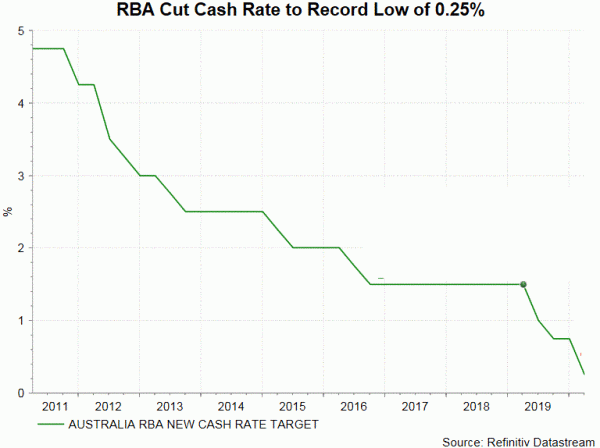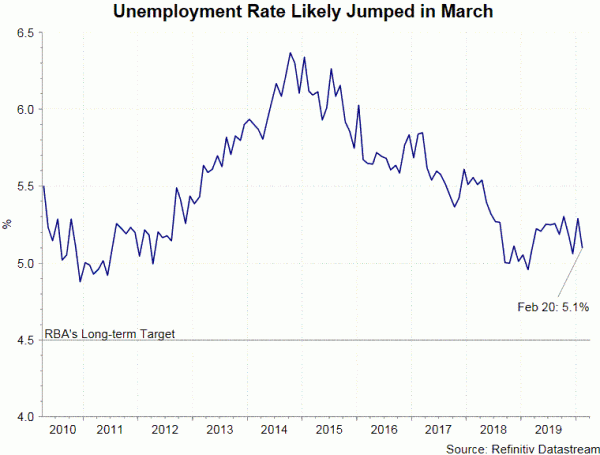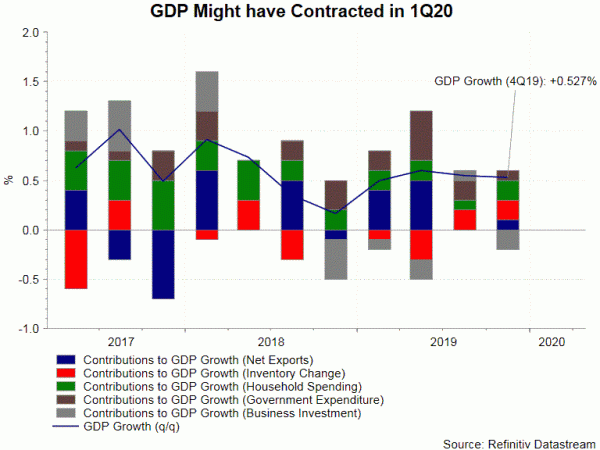As widely anticipated, RBA left the cash rate unchanged at 0.25% in April. This is following two emergency rate cuts (50 bps in total) a month ago. The central bank pledged to maintain the stimulus measures announced last month for combating the coronavirus pandemic. Aussie gained after the announcement on RBA’s apparently less dovish tone.
 On economic developments, policymakers noted that there is “considerable uncertainty about the near-term outlook for the Australian economy”. They added that the outlook “much will depend on the success of the efforts to contain the virus and how long the social distancing measures need to remain in place”. In the near-term, “a very large economic contraction is, however, expected to be recorded in the June quarter and the unemployment rate is expected to increase to its highest level for many years”.
On economic developments, policymakers noted that there is “considerable uncertainty about the near-term outlook for the Australian economy”. They added that the outlook “much will depend on the success of the efforts to contain the virus and how long the social distancing measures need to remain in place”. In the near-term, “a very large economic contraction is, however, expected to be recorded in the June quarter and the unemployment rate is expected to increase to its highest level for many years”.
Concerning financial conditions, the RBA noted signs that global “markets are working more effectively than they were a few weeks ago. This improvement partly reflects the substantial measures undertaken by central banks”. Domestically, RBA noted that “the Australian financial system is resilient. It is well capitalised and in a strong liquidity position, with these financial buffers available to be drawn down if required to support the economy”.
In order to contain the present economic crisis, RBA lowered the policy rate, each by -25 bps, in March 3 and March 19. Meanwhile, it announced to buy government and semi-government bonds across the yield curve, targeting the yield on 3-year Government bonds at around 0.25%. Besides, the central bank launched a 3-year funding facility of at least AUD90B for the banking system to target SMEs. It will also conduct one-month and three-month repos, and pledged to conduct repo operations of 6-months maturity or longer, on weekly basis.
At the April meeting RBA reiterated the commitment to implement the above measures. It affirmed that it “will do what is necessary to achieve the 3-year yield target”. RBA suggested that “If conditions continue to improve, though, it is likely that smaller and less frequent purchases of government bonds will be required”. Moreover, the members indicated that “given the substantial liquidity that is already in the system and the commencement of the Term Funding Facility, the daily open market operations are likely to be on a smaller scale in the near term. Operations at longer terms will continue, but the frequency of these operations will be adjusted as necessary according to market conditions”. These comments sent Aussie higher immediately.
It is likely that Australia would record decline in GDP in the first quarter and technically enter recession in the first half of the year. Meanwhile, an increase in the unemployment rate should make it more challenging for the central bank to achieve its long-term target of 4.5%. We expect RBA would continue to provide ample liquidity to the market in coming months.














